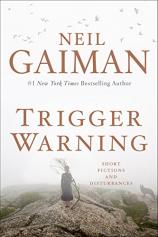Reading Group Guide
Discussion Questions
Trigger Warning: Short Fictions and Disturbances

1. Neil Gaiman begins the introduction to TRIGGER WARNING with two seemingly dissimilar ideas: taking a journey and wearing a mask. In what way is beginning a book like beginning a journey?
2. He writes, “We are all wearing masks. That is what makes us interesting. These are stories about those masks, and the people underneath them.” Does this idea illuminate anything about the characters in the book for you? What does the idea of mask-wearing mean for you as a reader?
3. Also in the introduction, Gaiman refers to short stories as “small adventures” he can take as a writer. Are short stories also small adventures for readers? What are some of the pleasures and surprises one can find in a short story that aren’t found in a novel?
4. Gaiman shares some background or inspiration about each story at the beginning of the book. Did you read this section before or after you read the stories themselves? How did reading these introductions before the stories color your reading of them? Or, how did the introductions enhance your understanding or appreciation of the stories after having read them? Did the introduction section and “Making a Chair” help you understand Gaiman’s writing process and storytelling intentions?
5. What is a “trigger warning”? Why is it an apt reference and title for this collection? Gaiman explains that the book is “filled with stories in which things happen, and many of those stories end badly for at least one of the people in them. They are not safe, even if they are friendly.” What triggers might the stories pull for readers? In this instance, can the emotional challenge of the tales be a positive thing?
6. In “The Truth is a Cave in the Black Mountains…” the narrator states “everything has its cost.” What does that mean for the characters in this story in particular and for characters in other stories in the collection? Which characters lost the most or paid the highest costs? What do they gain in exchange, and does the high cost ever seem worth what they gain?
7. Secret, prophetic or mystical knowledge seems to be a trait shared by many of the characters in TRIGGER WARNING. How trustworthy are characters like the guide in “A Lunar Labyrinth,” the mother in “Adventure Story” or the wife in “Jerusalem”? Do you take their perspective at face value or look for a deeper cause or origin of their beliefs and actions? Do fantasy and horror stories need to be read with a suspension of disbelief, or can they be read from a purely psychological perspective as well?
8. In reading “And Weep Like Alexander,” did anything come to mind that you think should be uninvented? What would be the consequences of uninventing it? Do you imagine uninvention, as Polkinghorn does, as “for the good of all” or as a more selfish or self-motivated act? Are we always stuck with the mistakes we’ve made or the disasters we’ve created? How would the world be different if we could change the mistakes or erase the disasters?
9. “Nothing O’Clock” and “Diamonds and Pearls” which appear back to back in this collection, are very different types of stories. The first is a science fiction story starring Doctor Who and the second a fairy tale, but both take the bones of their respective genres and add new elements. In what ways do these stories seem familiar and referential, and in what ways are they surprising and inventive?
10. How do “Observing the Formalities” and “The Sleeper and the Spindle” play with the Sleeping Beauty and Snow White fables? Did you readily see this connection?
11. There are many and diverse dangers described in TRIGGER WARNING. Some are physical and others metaphysical, some are emotional and some involve a threat to reason or logic. Which kind of danger do you find the most frightening and why? Which story was the scariest, the most chilling or the most disturbing?
12. The Queen in “The Thin White Duke” tells the Duke, “We are the end of everything, where nothing exists but what we create, by act of will or by desperation…You do not have to die. You can stay with me. You will be happy to have finally found happiness, a heart, and the value of existence. And I will love you.” Do you think her promise is of the kind that most of the characters in the collection are searching for? If so, why does the Duke reject her offer? What motivates the characters in TRIGGER WARNING the most, and what are they seeking or hoping for?
13. Think about the love letter that is “Feminine Endings” and compare the deceptively simple desires of that narrator with both the Queen and the Duke in “The Thin White Duke.”
14. In what ways do the poetic pieces in this collection tell stories as full as the short stories? In what ways are the short stories as evocative and lyrical as the poems?
15. In the introduction, Gaiman writes that short story collections “should not, hodge-podge and willy-nilly assemble stories that were obviously not intended to sit between the same covers.” He goes on to say that this particular collection “fails this test.” Do you agree or disagree? What did you enjoy about the variety of styles and genres found in TRIGGER WARNING?
16. What is your favorite story in the collection and why? Did you respond to it emotionally, intellectually or aesthetically?
Trigger Warning: Short Fictions and Disturbances
- Publication Date: February 3, 2015
- Genres: Fiction, Short Stories
- Hardcover: 352 pages
- Publisher: William Morrow
- ISBN-10: 0062330268
- ISBN-13: 9780062330260








